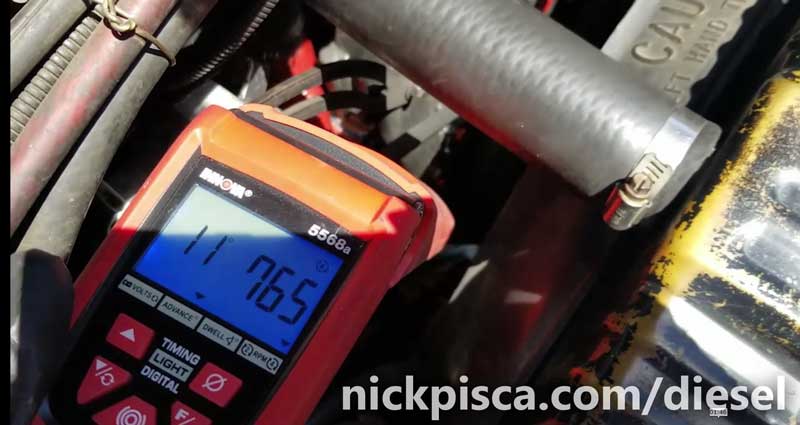If I’m going to be completely honest, I’ve always been skeptical of the assertion that lift-pump fuel pressure impacts the timing of the injector pump. When you examine the functionality of the IDI IP, it seems kind of irrelevant if your lift- or e-pump is pushing 1 psi or 10 psi.
But to satisfy my own curiosity, I decided to conduct a not-so-scientific experiment with my timing gun and ferret meter:
With the test conducted at idle (because the roar of an idling engine is more audible on a conventional microphone when compared to the roar of a revved engine), there is a 3.5 – 4 deg BTDC difference between 10 psi and 0 psi fuel pressure. It is important to note that this pressure is OUTSIDE of the IP. This is not internal IP fuel pressure.
Considering that most e-pumps and lift-pumps won’t deviate more than a few psi at the most taxing and least taxing fuel consumption rates, the overall impact on injection pump timing is minimal. But the test does prove that with a large enough pressure differential, the timing can be adversely retarded.
The only way this would be mildly noticeable, would be if the fuel filter was mildly clogged, thus restricting flow enough to build up a vacuum or low pressure situation, while in some aggressive stop-and-go traffic. Another case could be if the lift- or e-pump was starting to fail, and was leading to ok fuel pressure, but lack of fuel flow, measured in gallons per minute (gpm). The optimal IDI fuel flow rate varies from IP to IP, because a stock IP can have a much lower fuel flow requirement than my R&D 90 cc IP. The last case the fuel pressure could alter the timing would be if a fuel line got kinked or clogged just enough to let moderate fuel flow, but not enough for when the driver needs excess fuel to climb a decent grade or pull a load. One could verify their fuel system has a good flow rate by temporarily rigging up a vac bleeder pump on the lines and see if has uncharacteristically high resistance rate.
Overall, this little experiment taught me something. The old codgers on the forums are not as senile as I thought. Yet.
No warranty. You are responsible for your vehicle. For novelty use only. Not responsible for anything or anyone. Not responsible for damage to your vehicle, you, or anyone or anything.
Copyright 2000-2018 Nick Pisca 0001D LLC


